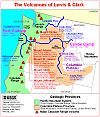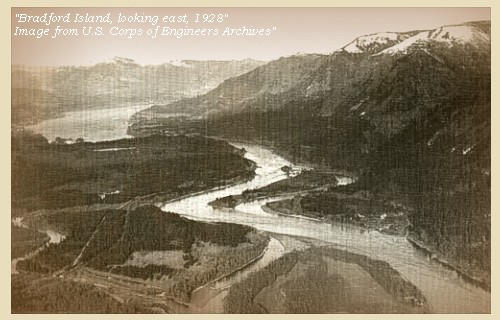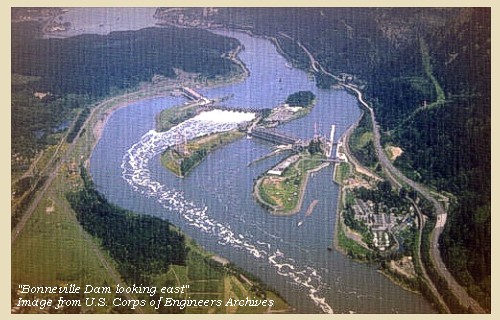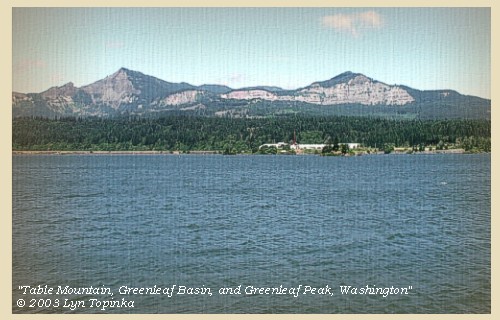The Volcanoes of
Lewis and Clark
Lewis and Clark
|
April 10 - 11, 1806 Columbia River Gorge - Bonneville Vicinity |
|
Home
The Volcanoes of Lewis and Clark Map of the Journey Volcanoes, Basalt Plateaus, Major Rivers, etc. The Volcanoes Mount Adams, Mount Hood, Mount Jefferson, Mount Rainier, and Mount St. Helens CALENDAR of the Journey October 1805 to June 1806 Along the Journey Pacific Northwest Maps - Columbia River, Volcanoes, Flood Basalts, Missoula Floods, Geology, etc. The Corps of Discovery The Journey of Lewis and Clark About the Reference Materials The Journals, Biddle/Allen, DeVoto, Gass, Moulton, Topo Maps, and others USGS Lewis and Clark Links Links to USGS Websites highlighting the Lewis and Clark Journey Resources Publications Referenced and Websites Visited |
PREVIOUS
April 9 Columbia River Gorge, Cottonwood Beach Camp to Bonneville |
April 10-11
Columbia River Gorge, Bonneville Vicinity Bradford Island, Bonneville Dam, Bonneville Landslide |
CONTINUE
April 12 Columbia River Gorge, "Lower Falls of the Columbia", Cascade Locks |
|
Heading for Home - April 1806
Columbia River Gorge - Bonneville Vicinity |
| Lewis and Clark's camp of April 9, 1806, was on the Oregon side of the Columbia River, at a location now near the Bonneville Dam, upstream of Tanner Creek and across from the lower tip of Bradford Island. |
| Thursday, April 10, 1806 |
| Early in the morning we dropped down the channel to the lower end of Brant island [Bradford Island], and then drew our boats up the rapid. |
| At the distance of a quarter of a mile we crossed over to a village of Clahclellahs, consisting of six houses, on the opposite side [Washington side, east of North Bonneville, location of the Bonneville Dam]. The river is here about four hundred yards wide, and the current so rapid, that although we employed five oars for each canoe, we were borne down a considerable distance. ...... |
| The south side of the river is impassable, and the rapidity of the current as well as the large rocks along the shore, render the navigation of even the north side extremely difficult. During the greater part of the day it was necessary to draw them along the shore, and as we have only a single tow-rope that is strong enough, we are obliged to bring them one after the other. In this tedious and laborious manner, we at length reached the portage on the north side [area of the Bonneville Landslide], and carried our baggage to the top of a hill, about two hundred paces distant, where we encamped for the night [Washington side, above today's Bonneville Dam]. |
| The canoes were drawn on shore and secured, but one of them having got loose, drifted down to the last village, the inhabitants of which brought her back to us; an instance of honesty which we rewarded with a present of two knives. It rained all night. |
|
|
|
The Camp - April 10 and April 11, 1806:
Lewis and Clark camped on the Washington side of the Columbia, at a location now above the Bonneville Dam. |
| Friday, April 11, 1806 |
| The tents, and skins which covered the baggage, were wet. We therefore determined to take the canoes first over the portage [across Bonneville Landslide, passed the rapids and falls of the Cascade Locks area], in hopes that by the afternoon the rain would cease, and we might carry our baggage across without injury. This was immediately begun by almost the whole party, who in the course of the day dragged four of the canoes to the head of the rapids, with great difficulty and labour. ...... |
| "... this portage is two thousand eight hundred yards along a narrow rough and slipery road. ..." [Lewis, April 11, 1806] |
| "... rained the greater part of last night and continues this morning. all of the party except a fiew to guard the baggage turned out with Capt. Clark to takeing up our canoes with the tow Rope up the big Shoote took one large one and one Small one at once the large one filled at the highest pitch where it is allmost perpinticular but with Some difficulty we got the 2 to the head of the portage about noon. then went back took dinner and took another large canoe and a Small one the other smallest one was taken & carried by land. this large canoe filled twice with water at the worst pitch but with some difficulty & hard fatigue got them Safe up towards evening by the assistance of a number of Indians at the worst pitch &C. and halled the large canoe up by force allthough She was full of water. the most of the mens feet sore towing over the Sharp rocks. our officers made a chief of the nation gave meddle &C. Drewyer and the 2 Fields Sent on a head with their little canoe to a creek on the N. Side to hunt untill our arival. ..." [Ordway, April 11, 1806] |
| "... by the evening Capt. C. took 4 of our canoes above the rapids tho' with much difficulty and labour. the canoes were much damaged by begin driven against the rocks in dispite of every precaution which could be taken to prevent it. the men complained of being so much fatiegued in the evening that we posposned taking up our 5th canoe untill tomorrow. these rapids are much worse than they were fall when we passed them, at that time there were only three difficult points within seven miles, at present the whole distance is extreemly difficult of ascent, and it would be impracticable to decend except by leting down the empty vessels by a cord and then even the wrisk would be greater than in taking them up by the same means. the water appears to be (considerably) upwards of 20 feet higher than when we decended the river ..." [Lewis, April 11, 1806] |
| Many Indians from the villages above, passed us in the course of the day, on their return from trading with the natives of the valley, and among others, we recognised an Eloot, who with ten or twelve of his nation were on their way home to the long narrows of the Columbia. These people do not, as we are compelled to do, drag their canoes, up the rapids, but leave them at the head, as they descend, and carrying their good across the portage, hire or borrow others from the people below. When the trade is over they return to the foot of the rapids, where they leave these boats and resume their own at the head of the portage. The labour of carrying the goods across is equally shared by the men and women, and we were struck by the contract between the decent conduct of all the natives from above and the profligacy and ill manners of the Wahclellahs. About three quarters of a mile below our camp is a burial ground, which seems common to the Wahclellahs, Clahclellahs, and Yehhuhs. It consists of eight sepulchres on the north bank of the river. |
|
|
|
The Camp - April 10 and April 11, 1806:
Lewis and Clark camped on the Washington side of the Columbia, at a location now above the Bonneville Dam. |
| Home | Previous | Continue |
If you have questions or comments please contact: GS-CVO-WEB@usgs.gov
June/July 2004, Lyn Topinka
The Volcanoes of Lewis and Clark Home Page | CVO Home Page























